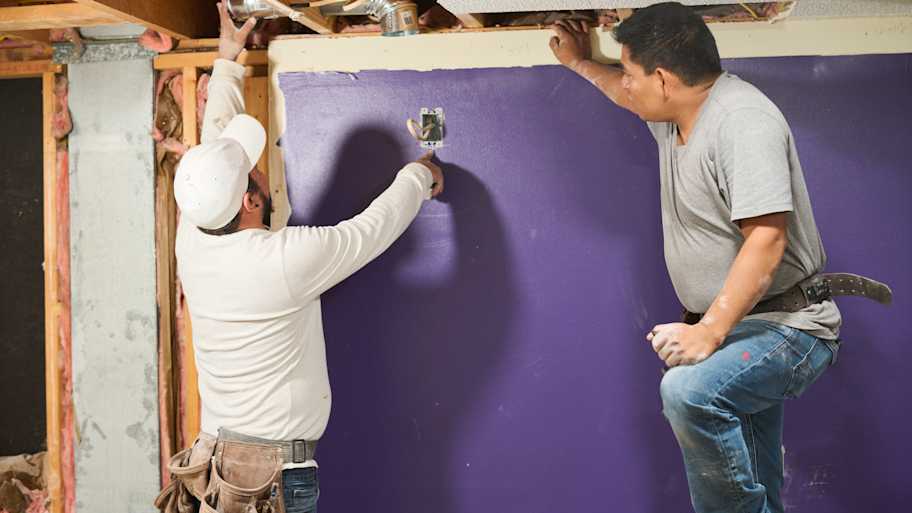Cracks in Drywall Ceiling Seam: Causes, Fixes, & More
There are a few causes for cracks in drywall ceiling seams, ranging from water damage to something as simple as the house settling


Cracks in your drywall between your ceiling and walls can seem like your house is about to come apart at the, well, seams. But don’t start thinking that the sky is falling just yet, Chicken Little. There are some common causes and simple fixes that you can implement so you (and your home) can keep it together.
What Causes Seam Cracks?
If you see cracks in your drywall ceiling seam, the culprit is usually one of six things.
1. Water Damage
Water may be life, but it can wreak havoc on your home if it’s leaking somewhere. You need to address water damage as quickly as possible, whether it’s leaking in from the roof or coming through the floor above your ceiling. If there’s a bathroom above the area where you see the crack or if you’ve just had heavy rain, be sure to get a professional in to investigate.
2. Heavy Stuff
While floors support furniture and all manner of heavy items, if you have something especially heavy above the crack, it might be time to clear that area up a little bit. Bathtubs are often a culprit here as well, since they’re quite heavy and need extra support. If that support is missing, it can cause your ceiling and walls to crack one floor down.
3. Improperly Installed Drywall
If installed improperly, drywall can crack pretty easily. The culprit, in this case, is improper taping. Basically, contractors install drywall in sheets and stick it together with drywall mud. Then, tape is put on over the mud before you paint. If that seam is between the drywall and, in this case, an improperly sealed ceiling, the tape will start to lift and form a crack. Fortunately, cracks in ceiling drywall are usually not serious; you or a pro can patch them pretty easily.
4. Aging Home
It happens—humans get wrinkles on their faces as they age, homes get cracks in their ceilings. As a home gets older, the foundation settles, which can cause cracks in ceilings, walls, and even flooring.
5. Foundation Problems
Don’t confuse normal foundation settling with foundation problems. If your foundation has been damaged somehow, whether by soil settlement, bad construction, water, or insects like termites, it can radiate through your entire home. Cracks more than a quarter-inch wide are signs of serious structural problems, and you should have a professional come and look at your foundation ASAP.
6. Truss Lift
A roof truss is composed of wood placed in a triangular “webbing” to support the roof. The ceiling of the house is then attached to the trusses with screws or nails. Because the ceiling structurally ties to the roof, any time the pieces of wood get wet and expand or dry and contract, there’s the potential for the drywall on the wall to pull away from the ceiling. These gaps are not a structural problem, but they can be an eyesore.
Before You Call a Pro

In most cases, you’ll need to call in a professional to at least diagnose the problem and determine whether you’ve got a structural issue on your hands. However, there are a couple of things you can do to investigate before making the call.
Check for Water Damage
Water damage can cause cracks in your drywall ceiling seam, so if you have access to the area above where the crack is, do some investigating. If the area is in the attic, check if there’s any water leaking through the roof or moisture on the floor near the problem area. If the area above the crack is a second-floor bathroom, check for visible water damage or leaking.
Check for Heavy Furniture
Since the weight of a bathtub is another possible cause of a ceiling seam crack, check to make sure it’s not below a second-floor bathroom. If it’s not, see if there’s any other heavy furniture that might be weighing down the flooring.
Check for Bugs
Signs of termite infestation are peeling paint, wood that sounds hollow, small holes in drywall, discolored or drooping drywall, and loosening tiles. If you see any of those signs, it’s time to call in a pest control professional to check for a termite problem.
DIY Fixes
There are a few ways you can deal with cracks in drywall ceiling seams yourself.
Leave It Alone
If you’ve examined the ceiling and walls and are certain that there’s no water damage, foundation issues, or bug problems, you can always choose to simply live with the crack. It might be a little unsightly, but this could be the easiest (and cheapest) solution depending on how noticeable it is.
With truss lifting, if you live in an area where it’s hot in the summer and cold in the winter, the expansion of the wood during warm times could cause the crack to disappear. Take note when you notice the crack in the year and monitor whether it goes away in the summer when the wood swells with the temperature.
Install Crown Molding
Again, if you’re certain that the issue is not structural, crown molding is a good way to hide cracks in the seaming between your ceiling and walls. Installing crown molding yourself is not labor-intensive, but make sure you seal the crack with good caulk before covering it.
When to Call a Professional
You should call a professional if you suspect termites, water damage, or foundational issues. Termites require a pest control professional and may require several treatments to take care of the problem. Water damage can permeate further into the structure of your home than you can see with the naked eye, so it’s important to call a plumber or contractor if you suspect water damage.
Foundation problems are the most serious cause of cracked drywall, so you should call in a contractor immediately if you think that’s the cause. If you don’t have a contractor you work with regularly, ask friends or neighbors for a recommendation or check online reviews and source several quotes before making your selection.





- Foundation Cracks: What’s Normal and When to Worry
- 8 of the Most Common Drywall Problems and How to Solve Them
- Who to Call for a Water Leak in Your Ceiling
- 10 Types of Drywall Cracks and What They Could Mean
- How to Repair Water-Damaged Drywall
- What to Do If Your New Roof Is Leaking
- When to Worry About Cracks in Your Basement Floor
- 11 Warning Signs of Foundation Issues
- How to Troubleshoot and Fix a Ceiling Leak
- 6 Costly Home Repairs That Could Be Hiding in Your Dream Home










